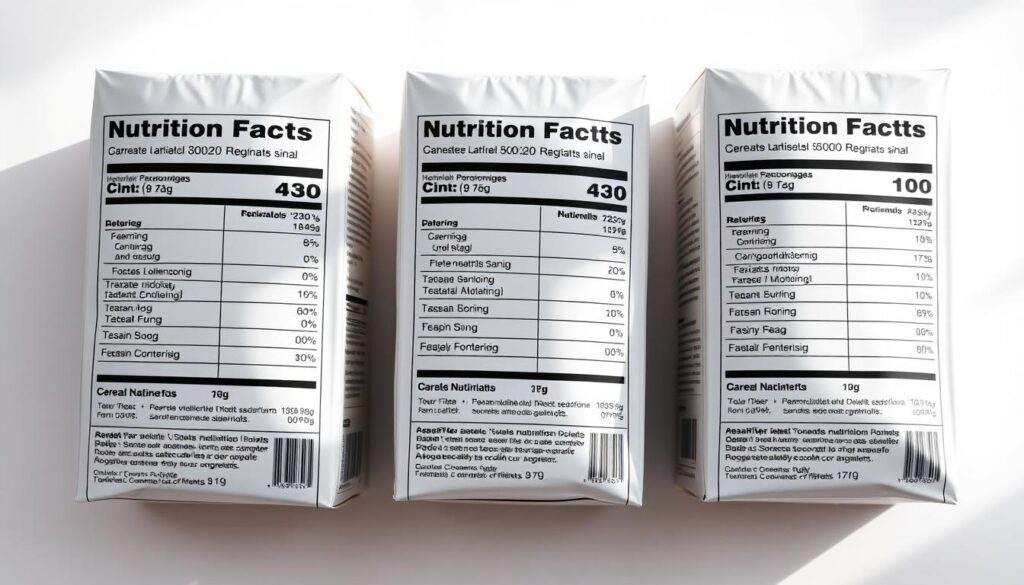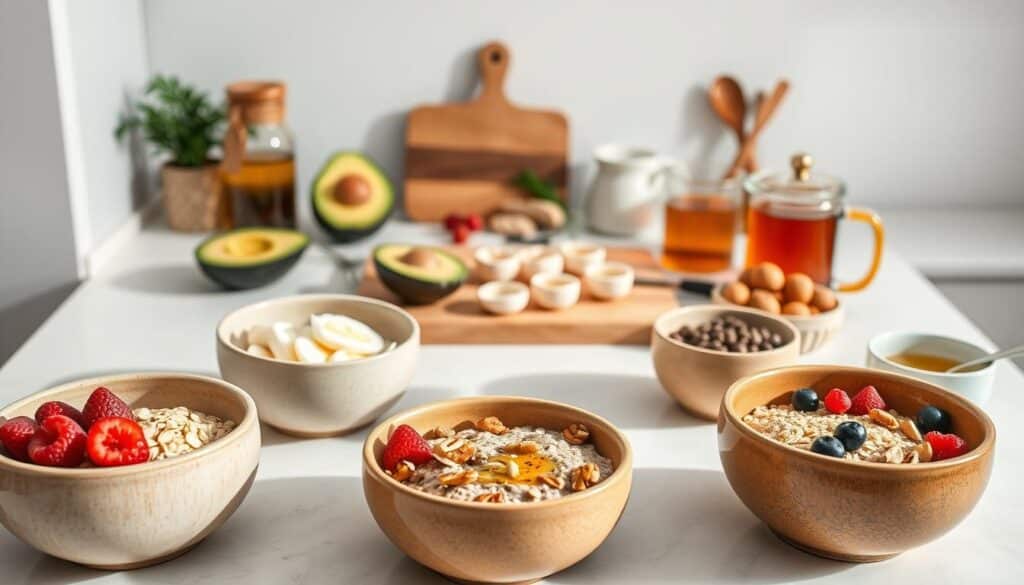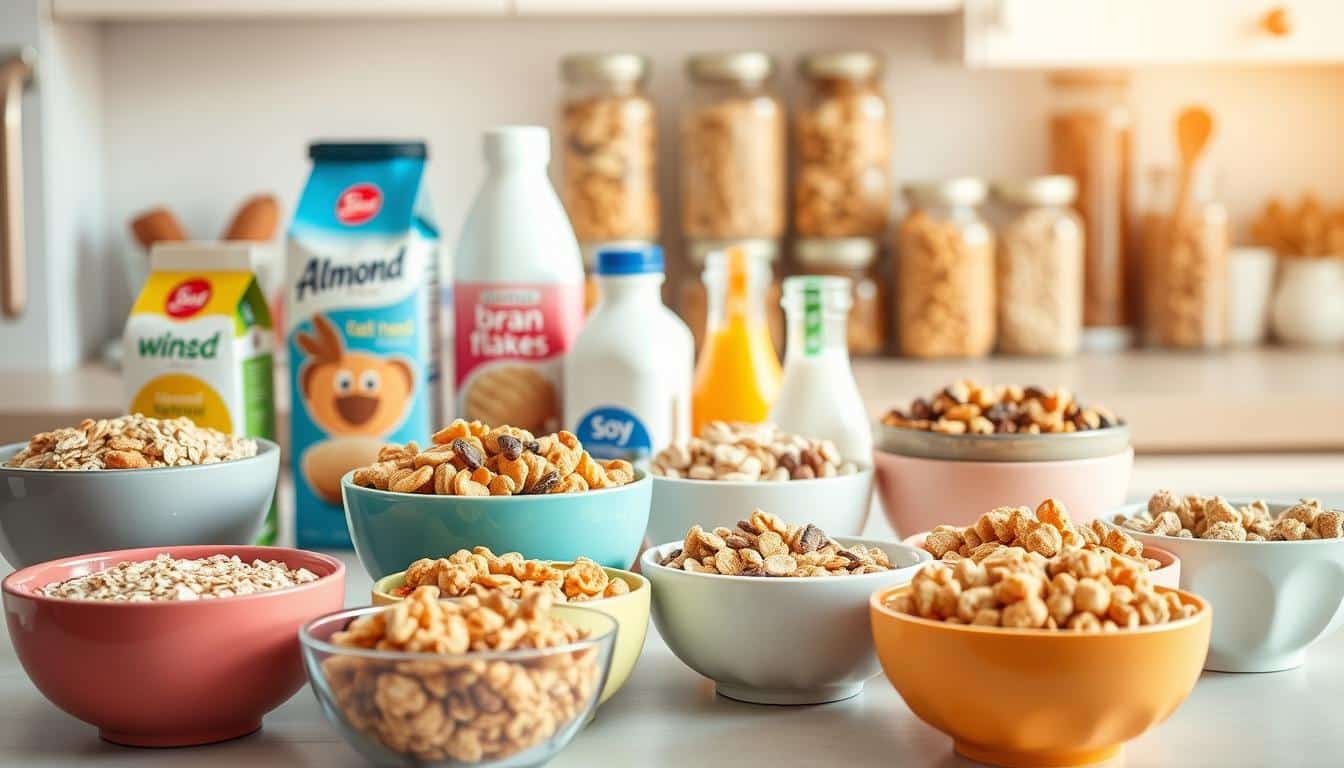Starting your day with the right breakfast plays a vital role in managing glucose levels. For those navigating diabetes, morning meals require careful planning—especially when selecting cereals. Many popular options hide added sugars or lack filling nutrients, creating spikes that disrupt energy and health.
Experts emphasize whole grains, high fiber, and low glycemic index ratings as key factors. Brands like Cascadian Farm Organic Purely O’s and Original Cheerios often top dietitian lists due to their minimal added sugars and balanced profiles. These choices help stabilize energy without rapid blood sugar fluctuations.
Reading labels becomes essential. Prioritize options with at least 3g of fiber per serving and protein sources like nuts or seeds. Pairing cereal with unsweetened almond milk or Greek yogurt adds staying power to your meal.
This guide simplifies the search by highlighting science-backed picks and practical strategies. You’ll learn how ingredients work together to support metabolic health—and discover tasty ways to enjoy breakfast without compromise.
Understanding Diabetes and the Role of Breakfast
For individuals managing type diabetes, morning nutrition sets the tone for daily blood sugar stability. This condition disrupts insulin production or usage, making balanced glucose levels critical. Uncontrolled spikes can lead to fatigue, cravings, and long-term complications.
Your breakfast cereal choice directly impacts this balance. Studies show meals rich in refined carbs cause rapid glucose surges, while fiber-rich options slow absorption. A 2021 Journal of Nutrition study found low-carb morning meals reduced afternoon blood sugar fluctuations by 28%.
Importance of Regulating Blood Sugar
Consistent glucose levels prevent energy crashes and support organ health. Diabetes management relies on avoiding extremes—neither prolonged highs nor dangerous lows. Breakfast skippers often experience both, according to CDC data.
Benefits of a Nutritious Morning Meal
Smart breakfast choices provide sustained energy through whole foods and protein. Pairing cereals with seeds or Greek yogurt enhances satiety. Always check labels: prioritize options listing whole grains first and sugars last.
Exploring the Glycemic Index and Glycemic Load
Carbohydrates impact blood sugar levels differently based on their structure. The glycemic index (GI) measures how quickly 50g of carbs in food raises glucose compared to pure sugar. This tool helps categorize foods into low (0-55), medium (56-69), or high (70-100) GI ranges.
Decoding Low, Medium, and High GI Foods
Slow-digesting options like rolled oats (GI 55) cause gradual glucose changes. Medium-GI choices, such as brown rice (GI 68), offer moderate effects. High-GI items like cornflakes (GI 81) trigger rapid spikes. Fiber and protein lower a food’s GI by slowing carbohydrate breakdown.
How Glycemic Load Informs Your Choices
While GI measures speed, glycemic load (GL) considers portion size. Watermelon has a high GI (72) but low GL (4 per slice) due to its water content. For diabetes management, prioritize low-GL cereals like bran flakes (GL 15) over sugary alternatives.
Pairing high-fiber cereals with nuts adds protein, further stabilizing energy. Always check labels: even “healthy” cereals may hide fast-acting carbohydrates that disrupt metabolic balance.
What is the best cereal for diabetics
Choosing the right breakfast cereal involves more than just taste preferences. It requires balancing nutritional value with metabolic impact. Three factors separate quality options from sugary traps: ingredient composition, fiber ratios, and sugar content.
Evaluating Cereal Options and Nutritional Value
Start by scanning nutrition labels for whole grain as the first ingredient. Products like Ezekiel 4:9 Sprouted Grain Cereal use 100% sprouted grains, offering 6g of fiber per serving. Compare total carbs against dietary fiber—aim for at least a 5:1 ratio.
Beware of misleading claims like “made with whole grains.” Verify this by checking if refined flours appear in the ingredients list. Steer clear of cereals listing sugar in their top three components—these often cause rapid glucose spikes.
Whole Grains, Fiber, and Added Sugars Considerations
Opt for minimally processed options like bran flakes or steel-cut oats. Their slow-digesting fiber content helps regulate blood sugar. A 2023 study showed adults with diabetes who ate high-fiber cereals reduced post-meal glucose by 22% compared to low-fiber choices.
Watch for hidden sugars disguised as honey, agave, or fruit concentrates. Pair your cereal with protein-rich toppings like walnuts or chia seeds to further stabilize energy levels. Remember: even “healthy” cereals can sabotage efforts if portion sizes aren’t controlled.
Tips for Choosing a Diabetes-Friendly Cereal
Mastering label literacy transforms cereal selection from guesswork to strategy. Three out of five people with diabetes overlook critical details in packaging claims, according to ADA research. Focus on these actionable steps to build better breakfast habits.

Reading Nutrition Labels Effectively
Flip the box and check the serving size first. Many breakfast cereal brands list unrealistically small portions—like ¾ cup—to downplay sugar content. Compare this to your typical bowl size. Next, scan ingredients: whole grains should dominate the list, not sugars disguised as “brown rice syrup” or “fruit concentrate.”
Look for at least 3g of fiber per serving and under 5g of added sugar. Brands like Kashi Go Lean or Special K Protein meet these benchmarks while providing protein boosts. Avoid products listing multiple sweeteners in the top five ingredients.
Portion Control and Avoiding Hidden Sugars
Use measuring cups or a food scale initially to train your eye. A 2023 study showed people using visual cues alone consumed 40% more than recommended servings. Pair your measured cereal with unsweetened almond milk to slash sugar intake by 50% compared to regular dairy milk.
Enhance your bowl with chia seeds or sliced almonds for crunch without spiking sugar levels. These diet-smart options add protein and healthy fats, creating balanced breakfast ideas that keep energy steady until lunch.
Incorporating Whole Grains, Fiber, and Protein
Building a balanced breakfast starts with smart ingredient combinations. Whole grains form the foundation of diabetes-friendly meals, offering sustained energy without spiking glucose. Their intact bran and germ provide essential nutrients like magnesium and B vitamins.
Benefits of Whole-Grain Ingredients
Unlike refined grains, options like steel-cut oats or quinoa retain natural fiber. This slows carbohydrate absorption, preventing sudden blood sugar surges. A 2022 study found adults with diabetes who ate whole grains daily improved insulin sensitivity by 18%.
Swap processed cereals for oatmeal or 100% whole-grain bread. These choices deliver 4-6g of fiber per serving—key for maintaining steady energy levels. Always check labels to ensure “whole grain” appears first in ingredients.
Boosting Breakfast with Nuts, Seeds, and Protein Sources
Enhance your bowl with texture and nutrients. Sprinkle almonds or walnuts for crunch and healthy fats. Chia or flaxseeds add omega-3s and extra protein, helping you feel full longer.
Pair grains with Greek yogurt or a hard-boiled egg for a protein boost. Research shows meals combining fiber and protein reduce post-breakfast glucose spikes by 35% in those managing diabetes. Try stirring peanut butter into oatmeal or topping toast with avocado and pumpkin seeds.
Simple swaps create satisfying meals. A handful of nuts or scoop of seeds transforms basic cereals into nutrient-packed power bowls—no sugar crashes required.
Alternatives to Traditional Breakfast Cereals
Morning meals don’t need to revolve around boxed cereals. Expanding your options helps maintain variety while supporting blood sugar balance. Hot foods like steel-cut oats or quinoa porridge offer warmth and nutrients without processed ingredients.

Exploring Hot Cereals and Porridges
Swap cold cereal for hearty alternatives. Oatmeal made with rolled oats provides 4g of fiber per serving—ideal for slowing carb absorption. Try quinoa porridge: cook ½ cup quinoa in unsweetened almond milk, then top with cinnamon and walnuts.
Muesli is another smart choice. Combine raw oats, chia seeds, and chopped almonds. Soak overnight in Greek yogurt for added protein. These foods deliver sustained energy, crucial for managing diabetes.
Creative Mixed-Meal Breakfast Ideas
Break free from sweetened bowls. Sauté spinach and mushrooms, then pair with scrambled eggs and avocado. This savory meal offers healthy fats and minimal carbs.
For a grab-and-go option, layer unsweetened coconut yogurt with berries and pumpkin seeds. Research shows protein-rich breakfasts reduce mid-morning cravings by 30% in those with diabetes.
Experiment with texture and flavor. Roasted chickpeas add crunch to oatmeal, while nut butter swirls enhance creaminess. These tweaks transform simple food into satisfying experiences that stabilize glucose naturally.
Practical Strategies for a Healthy Breakfast Routine
Optimizing morning nutrition requires more than just food choices—it demands strategic timing and smart combinations. Research shows aligning meals with activity patterns enhances blood sugar levels management while fueling your body effectively.
Timing Your Breakfast Around Exercise
Eat 30-60 minutes before workouts to balance energy needs. Pair slow-digesting carbs like oats with protein-rich Greek yogurt. This combo helps raise blood glucose gradually, preventing mid-exercise crashes.
A 2022 study found people with diabetes who timed meals this way maintained steadier blood glucose during exercise. Avoid large portions—stick to ½ cup cereal with 1 tablespoon nuts for a light pre-workout boost.
Smart Pairings with Dairy or Plant-Based Milk
Swap sugary milk for unsweetened almond or soy varieties. These options slash added sugar by 75% while adding calcium. Top your bowl with chia seeds to increase protein intake naturally.
Research indicates combining high-fiber cereals with protein-rich milk reduces post-meal glucose spikes by 20%. Measure your serving size using a kitchen scale—most adults need ¾ cup cereal max for stable levels.
Consistency matters. Track responses to different pairings using a glucose monitor. Over time, these habits create routines that support long-term diabetes management without sacrificing flavor or convenience.
Conclusion
Navigating breakfast with diabetes demands awareness and intentional choices. Prioritizing whole grains, high fiber content, and protein-rich additions helps stabilize energy throughout the day. These strategies support balanced carb intake while minimizing glucose spikes—a critical factor for people managing type 2 diabetes.
Portion control matters as much as ingredient quality. Measuring servings and selecting low-GI options creates sustainable diet habits. Small adjustments, like swapping sugary cereals for bran flakes with nuts, yield lasting benefits.
Experiment with breakfast ideas that align with your lifestyle. Pairing smart carb choices with healthy fats and proteins transforms morning meals into metabolic allies. Track how different combinations affect your energy levels.
By applying these science-backed diet principles, people with diabetes can enjoy satisfying meals while supporting long-term health. Start tomorrow with one positive change—your body will thank you.
FAQ
Can oatmeal help manage blood sugar levels effectively?
Steel-cut or rolled oats with no added sugar offer soluble fiber, which slows glucose absorption. Pairing oatmeal with nuts or seeds adds protein and healthy fats for better blood sugar control.
Are low-carb cereals suitable for type 2 diabetes?
Yes. Look for cereals like Magic Spoon or Catalina Crunch with under 5g net carbs per serving. Prioritize options high in protein and fiber to avoid spikes in glucose levels.
How does glycemic load differ from glycemic index?
Glycemic index (GI) measures carb quality, while glycemic load (GL) factors in portion size. Low-GL foods like quinoa or barley-based cereals cause slower rises in blood sugar compared to high-GI refined grains.
What should you check on nutrition labels for diabetes-friendly cereals?
Focus on three metrics: fiber content (5g+ per serving), added sugars (avoid anything with syrup or honey coatings), and total carbohydrates. Brands like Kashi Go Lean or Post Shredded Wheat often meet these criteria.
Can adding milk impact blood sugar when eating cereal?
Yes. Opt for unsweetened almond milk or full-fat dairy to reduce carb intake. Avoid flavored or sweetened varieties, which can add 10–15g of hidden sugars per cup.
Are grain-free cereals a better option for managing diabetes?
Grain-free options like NuTrail Nut Granola use almond flour or coconut, offering fewer carbs and more healthy fats. However, check labels for calorie density and portion sizes to avoid overconsumption.
How can nuts and seeds enhance a diabetic-friendly breakfast?
Almonds, chia seeds, or flaxseeds add protein, fiber, and omega-3s, which stabilize glucose levels. Sprinkle them on Greek yogurt or low-sugar cereals like Nature’s Path Organic for a balanced meal.
Is cold cereal worse than hot cereal for blood sugar management?
Not necessarily. Choose cold cereals like Special K Protein or Cheerios with whole grains and minimal added sugars. Combine with protein sources like cottage cheese to slow digestion.
What are creative alternatives to traditional breakfast cereals?
Try chia pudding made with unsweetened milk, or savory options like scrambled eggs with avocado. These meals provide sustained energy without spiking blood sugar levels.
How important is portion control with cereal for diabetics?
Critical. Even low-GI cereals can raise glucose if overeaten. Use a measuring cup to stick to ½–¾ cup servings and pair with a hard-boiled egg or almond butter for satiety.


